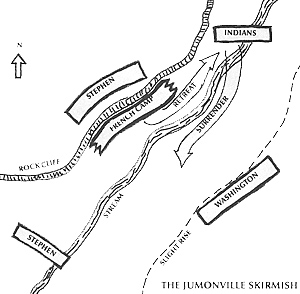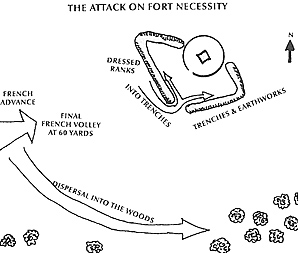
The French appeared in three columns from the forested hills on the southwest side of the fort sometime between nine and eleven o'clock in the morning. They formed an irregular skirmish line and began to advance toward the fort. They halted at about 600 paces from the fort and fired an ineffectual volley.
Washington had only 284 effectives out of a total force of less than 400. Those fit to fight were placed in dressed ranks in front of the earthworks, ready to blunt an anticipated charge by the French. The British held their fire as ordered. The much larger French force continued their regular advance. Sensing that the French had no intentions of charging across the open field, Washington and Mackay ordered their men to the trenches. The French advanced to within 60 paces of Ft. Necessity, fired again, then dispersed into the woods to the southeast.
The battle settled into a steady exchange of fire between the French in the woods and the British in the fort, mainly in the trenches. The French had the advantage of number and of cover. They picked off the defenders as they hid behind trees, while their opponents were exposed to fire every time they stood in the trenches to get off a shot. None of the French ventured out of the woods. The swivel guns at the fort were for the most part ineffective, when able to be fired, and the French with well placed shots suppressed their activity. Rain continued to fall, and although both sides had to contend with damp powder, the English got the worse even of the weather as their trenches became filled with water.
 Firing decreased during the afternoon, but increased again toward evening until torrential rain made shooting impossible. Washington expected a bayonet and tomahawk charge from the French and Indians. He ordered his men to fix bayonets to repel the expected attack. Instead many of the inhabitants of the fort took to drinking the rum from the storehouse and got drunk. Fortunately the anticipated attack never materialized.
Firing decreased during the afternoon, but increased again toward evening until torrential rain made shooting impossible. Washington expected a bayonet and tomahawk charge from the French and Indians. He ordered his men to fix bayonets to repel the expected attack. Instead many of the inhabitants of the fort took to drinking the rum from the storehouse and got drunk. Fortunately the anticipated attack never materialized.
About 8 o'clock the French came forth with an offer to negotiate. After initial hesitation Washington agreed and sent Capt. Van Braam and Ensign Peyroney, the only two men in his party that spoke French, to parley with de Villers. The terms that Van Braam and Peyroney brought back to the fort were, under the circumstances, very generous. The English would surrender the fort and retire with the honors of war. They could take their weapons and as much other property as they could carry. The Jumonville prisoners would be returned and two British hostages would remain to insure their return. Washington accepted and signed the "articles of capitulation". Unknowingly Washington also signed his "confession" to the assassination of Jumonville, in an article mistranslated by Van Braam.
Washington's Assassination?
Perhaps now is an appropriate time to return to history's judgements of Washington's actions against Jumonville. Gilbert Leduc, a priest with French Canadian ancestry, published the results of many years of historical research in a 235-page book, Washington and the Murder of Jumonville, in 1943. He concluded that Jumonville was at the very least carrying out reconnaissance and may very well have been spying. He further stated that Jumonville's actions were not those of a man on a diplomatic mission.
Dr. Marcell Trudel, professor of Canadian History at Laval University in Quebec supported Leduc's conclusions in a 1952 paper after finding new information in The Contrecoeur Papers. He concluded that Jumonville was killed in an engagement and was not assassinated.
Washington, Mackay and the rest of the survivors able to walk marched out of Fort Necessity on the morning of July 4, 1754. Eleven men remained behind to care for the wounded who could not be moved. Capt. Van Braam and Capt. Strobo remained as the hostages demanded by de Villers.
The battle cost the British 30 men killed and 70 wounded. The French and Indians had two Frenchmen and one Indian killed, and fifteen Frenchmen and two Indians wounded.
De Villers destroyed and burned Ft. Necessity, then returned to Ft. Duquesne. Washington's band marched to Wills Creek and from there returned to Virginia. So ended the first attempt to drive the French from the Ohio Valley. In the summer of 1754 and for several years to follow the French were in firm control.
ADDITIONAL READING
Alberts, Robert C. A Charming Field for an Encounter. Washington, DC: National Park Service,
1975.
Chartrand, Rene. The French Soldier in Colonial America. Bloomfield, Ont.: Museum Restoration Service, 1984.
Cleland, Hugh. George Washington in the Ohio Valley, Pittsburgh: University of Pittsburgh Press, 1955.
Hunter, William A. Forts on the Pennsylvania Frontier, 1753-1758. Harrisburg: The Pennsylvania Historical and Museum Commission, 1960.
James, Alfred P. and Charles M. Stotz. Drums in the Forest. Pittsburgh. The Historical Society of Western Pennsylvania, 1958.
O'Meara, Walter. Guns at the Forks. Pittsburgh: University of Pittsburgh Press, 1979.
Parkman, Francis. Montcalm and Wolfe. Boston: Little, Brown and Company, 1900. (There are many other editions of this 1884 classic available)
Peckham, Howard H. The Colonial Wars 1689-1762. Chicago: The University of Chicago Press, 1964.
More Rid the Ohio of the French
Back to Table of Contents -- Courier Vol. VIII No. 3
To Courier List of Issues
To MagWeb Master Magazine List
© Copyright 1988 by The Courier Publishing Company.
This article appears in MagWeb (Magazine Web) on the Internet World Wide Web.
Other military history articles and gaming articles are available at http://www.magweb.com